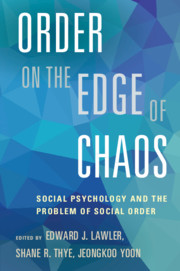Book contents
- Frontmatter
- Contents
- List of Contributors
- Preface
- 1 Social Psychology of Social Order: An Introduction
- 2 The Evolutionary Biology and Sociology of Social Order
- 3 Social Rationality and Weak Solidarity: A Coevolutionary Approach to Social Order
- 4 An Integrative Theory of Action: The Model of Frame Selection
- 5 The Center Cannot Hold: Networks, Echo Chambers, and Polarization
- 6 Social Exchange and Social Order: An Affect Theory Approach
- 7 Institutions, Trust, and Social Order
- 8 Identity Verifi cation and the Social Order
- 9 Identities, Roles, and Social Institutions: An Affect Control Account of Social Order
- 10 The Gender Frame and Social Order
- 11 Status, Power, and Social Order
- 12 Interaction Order: The Making of Social Facts
- 13 The Arts of Together: Social Coordination as Dyadic Achievement
- 14 Dignity as Moral Motivation: The Problem of Social Order Writ Small
- 15 The Legitimacy of Groups and the Mobilization of Resources
- Commentary: Contrasts and Complementarities
- Index
- References
5 - The Center Cannot Hold: Networks, Echo Chambers, and Polarization
Published online by Cambridge University Press: 05 December 2015
- Frontmatter
- Contents
- List of Contributors
- Preface
- 1 Social Psychology of Social Order: An Introduction
- 2 The Evolutionary Biology and Sociology of Social Order
- 3 Social Rationality and Weak Solidarity: A Coevolutionary Approach to Social Order
- 4 An Integrative Theory of Action: The Model of Frame Selection
- 5 The Center Cannot Hold: Networks, Echo Chambers, and Polarization
- 6 Social Exchange and Social Order: An Affect Theory Approach
- 7 Institutions, Trust, and Social Order
- 8 Identity Verifi cation and the Social Order
- 9 Identities, Roles, and Social Institutions: An Affect Control Account of Social Order
- 10 The Gender Frame and Social Order
- 11 Status, Power, and Social Order
- 12 Interaction Order: The Making of Social Facts
- 13 The Arts of Together: Social Coordination as Dyadic Achievement
- 14 Dignity as Moral Motivation: The Problem of Social Order Writ Small
- 15 The Legitimacy of Groups and the Mobilization of Resources
- Commentary: Contrasts and Complementarities
- Index
- References
Summary
Abstract
A longstanding literature in the social sciences – from James Madison to James Hunter and from Robert Dahl to John Rawls – regards opinion polarization as a threat to social order. Yet consensus may prove equally harmful due to the stifling effects of “monoculture.” Contemporary social and political theorists have proposed a pluralist alternative in which cross-cutting divisions maintain diversity and tolerance. In this chapter, we examine polarization, consensus, and pluralism from a relational network perspective. We cite empirical evidence from studies of political polarization and cultural fragmentation suggesting that alignment across issue dimensions extends beyond hot button identity politics to include seemingly arbitrary lifestyle preferences. While pluralist theorists typically assume that cross-cutting divisions foster mutual tolerance and maintain diversity, we show that pluralism can also become unstable due to the self-reinforcing dynamics of homophily and social influence.
Things fall apart; the centre cannot hold;
Mere anarchy is loosed upon the world,
The blood-dimmed tide is loosed, and everywhere
The ceremony of innocence is drowned;
The best lack all conviction, while the worst
Are full of passionate intensity.
William Butler Yeats, “The Second Coming,” 1919INTRODUCTION
Rational choice theorists attribute the “Hobbesian problem of order” to the tension between individual self-interest and the collective interest of all. However there are empirical and theoretical limitations to this formulation of the problem. Empirically, some of history's most costly breakdowns of social order have involved “identity politics” whose practitioners are motivated by righteous indignation, religious zealotry, and ethnic prejudice, not by the maximization of individual payoffs. Theoretically, Van de Rijt and Macy (2009) used Heckathorn's (1991) “altruist's dilemma” (as when there are “too many cooks in the kitchen”) to show that social dilemmas can arise even in a population whose members want nothing more than to do what is best for others, without any regard to self-interest.
Accordingly, in this chapter we argue that the problem of order goes much deeper than the tension between individual and collective interests. The more fundamental problem is what Van de Rijt and Macy characterize as the tension between individual autonomy and collective interdependence. Social life is a complex system, more like an improvisational jazz ensemble – whose members influence one another in response to the influences they receive – than a symphony orchestra whose members dutifully play their assigned parts.
Information
- Type
- Chapter
- Information
- Order on the Edge of ChaosSocial Psychology and the Problem of Social Order, pp. 86 - 104Publisher: Cambridge University PressPrint publication year: 2015
References
Accessibility standard: Unknown
Why this information is here
This section outlines the accessibility features of this content - including support for screen readers, full keyboard navigation and high-contrast display options. This may not be relevant for you.Accessibility Information
- 5
- Cited by
